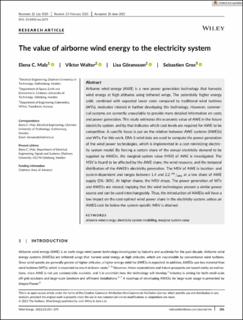| dc.description.abstract | Airborne wind energy (AWE) is a new power generation technology that harvests wind energy at high altitudes using tethered wings. The potentially higher energy yield, combined with expected lower costs compared to traditional wind turbines (WTs), motivates interest in further developing this technology. However, commercial systems are currently unavailable to provide more detailed information on costs and power generation. This study estimates the economic value of AWE in the future electricity system, and by that indicates which cost levels are required for AWE to be competitive. A specific focus is put on the relation between AWE systems (AWESs) and WTs. For this work, ERA-5 wind data are used to compute the power generation of the wind power technologies, which is implemented in a cost-minimizing electricity system model. By forcing a certain share of the annual electricity demand to be supplied by AWESs, the marginal system value (MSV) of AWE is investigated. The MSV is found to be affected by the AWE share, the wind resource, and the temporal distribution of the AWES's electricity generation. The MSV of AWE is location- and system-dependent and ranges between 1.4 and 2.2 urn:x-wiley:we:media:we2671:we2671-math-0001 at a low share of AWE supply (0%–30%). At higher shares, the MSV drops. The power generation of WTs and AWESs are related, implying that the wind technologies present a similar power source and can be used interchangeably. Thus, the introduction of AWESs will have a low impact on the cost-optimal wind power share in the electricity system, unless an AWES cost far below the system-specific MSV is attained. | en_US |

